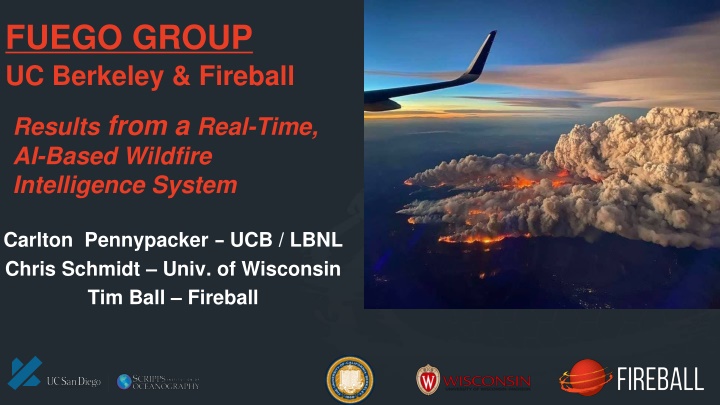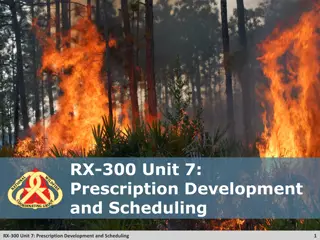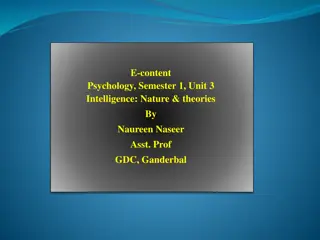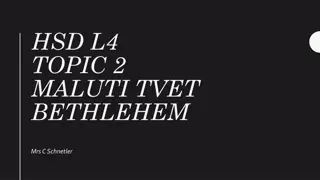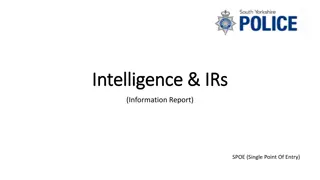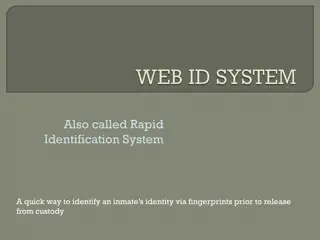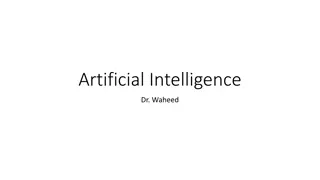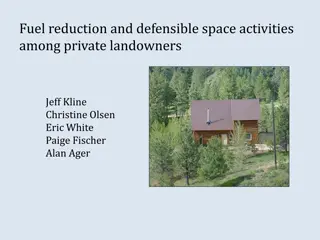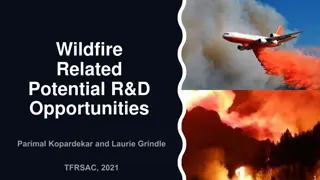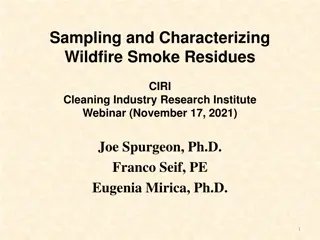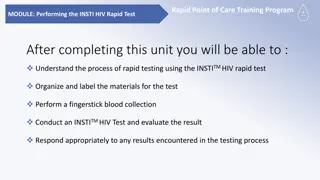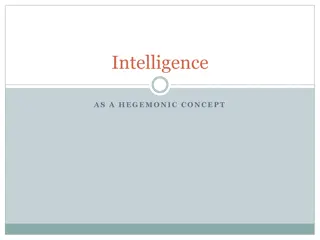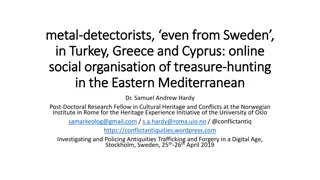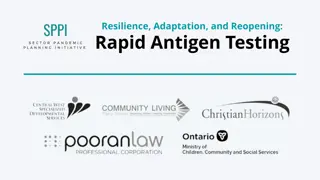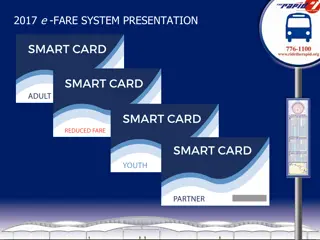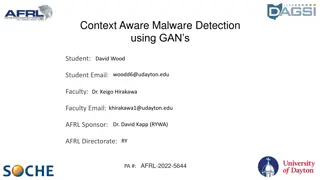Fuego: AI-Based Wildfire Intelligence System Detecting Rapid Wildfire Behavior
Fuego, developed by Fuego Group UC Berkeley and Fireball, is a real-time AI-based system focusing on wildfire behavior in the Wildland-Urban Interface (WUI). The system detects wildfires early, surpassing predictions for 2080 severity. It emphasizes the impact on low-income communities, particularly people of color, regarding the intersection of fires, global warming, COVID-19, and smoke exposure. Utilizing advanced technologies like machine learning, satellite data fusion, and camera networks, Fuego provides a crucial tool for detecting and assessing wildfires swiftly and effectively.
Download Presentation

Please find below an Image/Link to download the presentation.
The content on the website is provided AS IS for your information and personal use only. It may not be sold, licensed, or shared on other websites without obtaining consent from the author.If you encounter any issues during the download, it is possible that the publisher has removed the file from their server.
You are allowed to download the files provided on this website for personal or commercial use, subject to the condition that they are used lawfully. All files are the property of their respective owners.
The content on the website is provided AS IS for your information and personal use only. It may not be sold, licensed, or shared on other websites without obtaining consent from the author.
E N D
Presentation Transcript
FUEGO GROUP UC Berkeley & Fireball Results from a Real-Time, AI-Based Wildfire Intelligence System Carlton Pennypacker UCB / LBNL Chris Schmidt Univ. of Wisconsin Tim Ball Fireball
PROBLEM WILDFIRE BEHAVIOUR IS OFF THE CHARTS ALREADY EXCEEDING THE SEVERITY PREDICTED FOR 2080 It s Focused In The Wildland-urban Interface (WUI); Home To Many Low- And Fixed-income Folks. There Is Positive Feedback Between Fires And Global Warming Via Both CO2And Soot COVID & SMOKE INTERACTION* 16% greater impact on low-income people of color The Harvard Study found that low- income workers of color were more vulnerable to smoke, Covid and their combination. Fires were the source of more than 25% of the net CO2 emission from California in 2020. Roughly 15% in 2021. So it's an environmental justice issue that our society should be dealing with. John Balmes Pulmonologist UCSF, & CARB *Smoke increased Covid Case and Death Counts in Western US summer 2020. (F. Dominici, 2021, Harvard School of Public Health, in Press)
RAPID DETECTION: THE COST-EFFECTIVE KEY Constant Stare of Geo-stationary Satellites AI-based change detection Large Terrestrial Camera Networks Machine Learning
FUEGO CAM Machine Learning Smoke Detection Cloud and Edge Computing Large Camera Networks Verizon FrontLine
FUEGO CAM by the numbers Low rate of Omission Errors due to: - Good detection algorithm, - Ability to set detection in aggressive posture without fear of false positives. Low rate of Commission Error due to: - Training ML to affirmatively detect sources of false signals. - Fusion of ancillary data In Intelligence, context is everything Cameras in Networks Waiting PTZs Rotating Cameras 900+ per minute 2 4 Images/minute 1080 1440 2520 Images/Day 60% 40% 540 360 Total 3,628,800 Full System Error Rates Commission (False Positive) Omission (False Negative) Hovers around 1 per Million images Error: less than Ten Mile range Hovers around 1 per 4 Million images Error: greater than Ten Mile range Hovers around 1.5 per 1 Million images Omission defined as taking longer than 10 minute after first smoke. Notification of agencies occurs between 25 and 45 seconds after an image is acquired at the camera.
Satellite and Camera Data Fusion Camera vectors provide triangulation, Images provide assessment. Satellite provides coordinates and record of intensity estimates Important improvements in the GOES Fire Detection algorithm are possible. Including more bands, temporal pattern recognition, Ancillary data yields affirmative false positive recognition / rejection.
WHAT WERE HEARING Fireball s Fuego pinpoints the origin of fires and gives us the earliest ability to assess the threat. FUEGO s detections are delivered to the field , in the format we require, 24 /7/365 for us Fireball and its FUEGO technology is a game changer. Zach Wells, Deputy Chief 3 Wind-Driven Railroad Fires Kern County Fire
FUEGO GEOSTATIONARY RATIONAL Time from ignition to attack is crucial Prioritization between fires is essential Continuous automated monitoring from constant stare is indispensable (for both New & Existing) Detection: >8s for 30 m2of flame >1000 K (800 C) 200 x smaller fire than GOES-R Ground Sample Distance < 300 meters 10 Second Cadence 30 times faster than GOES CONUS Cost Effective ROM = $220 M for 5 year operation, all-up > 220 Million Hectares $0.02 per thousand hectare/hour -- continuous For Comparison Inexpensive Jet $2000/hr. @ 35,000 ft. AGL with 120 FOV Maps 2 Million Hectares per hour Cost = $1.00 per thousand hectares
FUEGO GEOSTATIONARY SPECS Detection: >8s for 30 m2at 1000 K Geo-stationary Free-Flyer Over Western US > 220 Million hectare field of regard Pointing Mirror: Field of Regard can be re-positioned Bands: RGB, 3.9 m, 10.2 m 4K x 4K MCT Array, 10 micron pitch Focal Length: 1000 mm (2.35 degree FOV) Optics: f/4 Effective GSD: < 300 meters (dithered for BPR) Array readable @ 100 Hz; planned read 0.5 Hz Simple image processing & compression on-board 10 msec read every 10 seconds, T=3.7K; 6 images co-added: SNR = 87 Transmit cadence: Every 10 Seconds -- 40 Mb/S or less All-up ROM for 5 year operation: $220M GOES ~0.6K T from 2 ms read, SNR~8.5
AIRBORNE FIRE CHARACTERIZATION & MAPPING SYSTEM Improve SCIENTIFIC & OPERATIONAL understanding of fire behavior 8 Mid-Wave Bands 2400 Cross-track Pixels 1 Longwave Band 1280 Cross-track Pixels Helicopter-borne follows fire front for science missions Fixed Wing for Operational Mapping
The FUEGO Group Ed Wishnow (UCB Space Sciences Lab) Harald Frey (UCB Space Sciences Lab) Greg Dalton (UCB Space Sciences Lab) Kodi Rider (UCB Space Sciences Lab) Cathy Chou (UCB Space Sciences Lab) Mike Lampton (UCB Space Sciences Lab) Chris Schmidt (Univ. of Wisconsin SSEC & GOES) Chaincy Kuo (Fireball) Rob Gordon (Fireball) Janis Lesinskis (Fireball) Marek Jakubowski (Fireball) Kent Richards (Fireball) Itsi Weinstock (Fireball) Morgan Welch (LBL Affiliate) Kinshuk Govil (LBL Affiliate) Michael Chan (LBL Affiliate)
